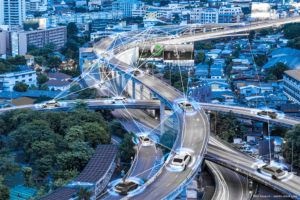– a use case in the 5G network –

Source: Adobe Stock
The future of mobility remains exciting: Rapid technological progress is opening up entirely new possibilities for the car of the future. Thanks to automated driving, we will be chauffeured from door to door in self-driving cars. Traffic jams, accidents and environmental damage could soon be a thing of the past. The realisation of this vision is approaching in leaps and bounds. RWTH Aachen University is actively helping to shape this mobility transformation.
With strong partners, of course – the Institute for Automotive Engineering (ika) , RWTH Aachen University.
In the future, vehicles will use digital technologies to inform each other about traffic situations and especially dangerous situations. If a vehicle uses its sensors to detect a condition that is important for other road users, e.g. obstacles, traffic jams, icy roads, aquaplaning, it will make this observation available to other road users via data exchange. The vehicles can thus react in a coordinated manner to an event, e.g. take evasive action or brake.
The data collected via sensors is exchanged directly between the vehicles on the one hand and stored in a common medium on the other.
Future intelligent transport systems (C-ITS = “Cooperative Intelligent Transport Systems”) like these can be connected with cloud services. The aim is to continuously ensure and improve the efficiency, safety and comfort of driving.
And this is where 5G technology comes into play.
Sensors for environment detection are located in and on vehicles as well as at strategically important points along the route (traffic lights, intersections, crossings, etc.) and communicate, for example, with the objects they detect via 5G. Due to the rapid speed, low latencies and good network coverage, the collected data can be sent and evaluated virtually in real time. Communication between the vehicles is optimised. This opens up completely new possibilities for autonomous driving.
The IT Center of RWTH Aachen University coordinates the provision of 5G technology for higher education institutions on campus – in this case the Institute of Automotive Engineering. The 5G infrastructure is operated in cooperation with partners on campus.
In its current research project “UNICARagil“, which is funded by the German Federal Ministry of Education and Research (BMBF), the ika is working, among other things, on the development of a cloud-based functional framework that will provide various valuable services to road users. The three main components of this framework are the collective environment model, collective memory and collective behaviour. The developed framework aims to support road users in their goal to accurately perceive their environment and plan safe, efficient and comfortable behaviour. It enables them to assess the accuracy of their perception algorithms by evaluating the discrepancy with the environment representations of other road users. To this end, mechanisms are being developed that can improve the perception and planning algorithms through continuous learning from the data collected in the field.
All this is only made possible by efficient radio technology. We are curious to see how this topic will develop and when these ideas will become reality.
One thing is certain: the IT Centre supports with the latest 5G technology.
Responsible for the content of this article is Frank Meeßen.




